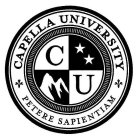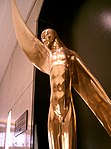Capella Tower

Capella Tower (also 225 South Sixth) is an office skyscraper in Minneapolis, Minnesota, United States. The building opened in 1992 as First Bank Place, replacing One Financial Plaza as the headquarters for First Bank System. In 1997, First Bank System acquired US Bancorp and changed the name of the building to US Bancorp Place. The headquarters of US Bancorp moved into the US Bancorp Center in 2000, whereupon the tower changed to 225 South 6th Street. In March 2009, the building took its present name. The ranking of the building as the tallest in Minneapolis is in dispute. The IDS Center is usually said to be taller by one foot, even by the owners of Capella Tower. It was initially said to be built one foot shorter out of respect for the IDS Center; however, in 2005, it was revealed that contractors had surreptitiously added 14 inches (36 centimeters) of height to Capella, therefore making it taller than the main roof of IDS Center. In February 2005, the IDS counted a 16-foot-tall (5-meter) window washing garage built on its roof in 1979 as part of its actual height, making it 14 ft (4.3 m) taller than Capella Tower. This ambiguity between official measurements and public relations statements might be due in some part to the "halo" that extends out from the roof, which is apparently included in the building's official height (though this is unclear).The IDS is taller on two measures. The IDS's communications spires add a significant amount of height making it 910 ft (280 m), and it remains the tallest building in Minneapolis if measured by number of stories (57 vs. 56; actually tied for first with neighbor Wells Fargo Center).Capella Tower is connected to the Minneapolis Skyway System and has 1.4 million square feet (130,000 m2). of office space.
Excerpt from the Wikipedia article Capella Tower (License: CC BY-SA 3.0, Authors, Images).Capella Tower
South 6th Street, Minneapolis
Geographical coordinates (GPS) Address External links Nearby Places Show on map
Geographical coordinates (GPS)
| Latitude | Longitude |
|---|---|
| N 44.9763 ° | E -93.2686 ° |
Address
Capella Tower
South 6th Street 225
55402 Minneapolis
Minnesota, United States
Open on Google Maps









